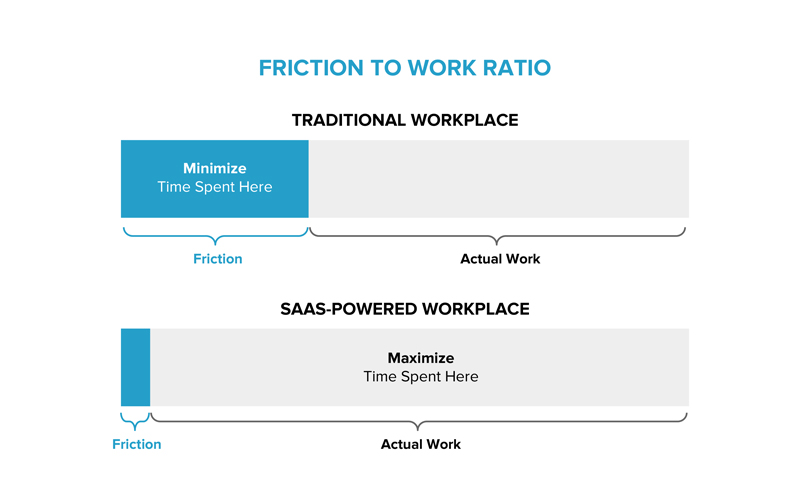Take a Stand Against the #1 Killer of Workplace Productivity
March 8, 2017
4 minute read

I got so much good feedback on this article that I decided to host a webinar to discuss the concept of “friction” in more detail. After getting emails, texts, and comments from a wide variety of people (both IT professionals and non-IT) saying they totally get it and hate friction, I thought this would be an interesting discussion. The webinar was held on April 12th. – David
I recently heard a true story about a company in the modern workplace that was amazing.
But not in a good way.
A severe winter storm had hit, resulting in an office closure for the day. So the employees, dutifully working from home, connected to the VPN server to remotely access their email and files. But then the VPN promptly crashed because it wasn’t equipped to handle the surge in traffic as the entire company attempted to connect all at once. The IT team then had to call–not email, because remember, nobody could access their email–every single person in the company, one at a time, to tell them to stop connecting to the VPN so that executives could check their email first.
My head is spinning just thinking about their ordeal. It’s like an absurd vaudeville act–brimming with obstacles within obstacles, like Russian nesting dolls–set in today’s so-called “modern workplace.” How much time do you think these beleaguered employees spent attempting to work, instead of working? How much productivity was lost that day, how much hair pulled out in frustration?
The Friction-to-Work Ratio
This company suffered from what I call a poor “friction-to-work” ratio. Friction is the time spent not working, but attempting to.
Friction kills productivity.
Naturally, businesses should want to ensure that employees are spending a high percentage of their time at work actually doing work. But when your employees’ amount of friction is high, then something is seriously awry.

In SaaS-Powered Workplaces, where organizations’ needs are fulfilled by a wide variety of best-in-breed cloud applications from many vendors, there is little friction. People can open their browsers and start working immediately. The less friction employees encounter, the more productive and efficient they can be.
But traditional workplaces have much more friction, and people are numb to it. Hundreds of millions of employees in workplaces around the world are inured to the daily hoops they must jump through to accomplish basic tasks. Despite incredible advances in technology, connectivity, and communication, many of today’s workplaces are equipped with technology that equates to stepping in a reverse time machine.
There are better technologies out there. There is a much, much better way to work. There is a promised land, and it’s time that people stand up and demand change in their workplace.
Friction: Public Enemy No. 1
Let me paint a portrait of the everyday friction some people still deal with today:
- Email. When you open Outlook, if you have a corrupt mail file or a mailbox exceeding its 5GB storage limit, it could literally take the first few hours of your day to access your inbox.
- Conference calls. All too often the first fifteen minutes of conference calls are wasted, peppered with the same unproductive questions: “Who’s here on the call?” “Who’s that new voice?” “Is someone’s baby crying in the background?” “Can you mute your line please?” “How many people are on the call now?” “Does everybody have the document?” (Furthermore, how do you know people are actively listening on conference calls? How can you read people’s reactions?)
- Document collaboration. When one person creates a Microsoft Word document and shares it with his team via email, people often blithely make their own local changes to it. This results in multiple versions flying back and forth, all named differently–Project v 1.1, Project_version_2, Project-Feb-14, ProjectFINAL-my-initials–and it becomes impossible to keep up with the latest version.
- Expense reports. Organizing a thick wad of receipts and taping them, one by one, to a sheet of paper is like doing a dull arts and craft project. Trying to fit them all together on one page is like doing an even duller puzzle. Between filling out expenses row by row in an Excel template, attempting to read the faded ink on the receipts, chasing down your manager to get approval by the deadline, you’re exhausted by the end of it.
The Promised Land: A Better Way to Work
So where’s the promised land? It’s right here. It exists. Email is the easiest and best way to communicate with anyone in the world. As such, it should be quickly accessible from any device at any time–and for many people using cloud-based email services, it is. You can do a video conference with the click of a button today. In fact, you don’t even need to be connected to Wifi; you can just use your phone’s 4G/LTE data connection. You can have dozens of participants on a single video call, you can mute them yourself, and you can read their facial expressions.
With real-time document collaboration, a team can knock out in 30 minutes what might have previously taken days or weeks. You can control who can edit and comment. There’s version control. Some of the biggest companies in the world use this technology. It’s actually incredibly gratifying to collaborate in a virtual workspace and see a document take shape and come to life right before your eyes.
And there are some amazingly intuitive applications that can make expenses friction-free. You can take a photo of your receipt with your phone, email it, and all the necessary information will be auto-scanned and auto-filled. Just click a button to submit the whole expense report virtually, and your manager can approve it virtually too.
Stop Passing the Buck
The bottom line is: We have to stop passing the buck, and it starts with leadership. Executives around the world must lead by demanding this technological change and not view it as a cost, but rather a prime opportunity to increase productivity and drive collaboration. It’s also a critical way to recruit the next generation of workers, who will demand that this kind of technology be in place.
If executives won’t drive this change, then IT needs to stand up and make the case to their executives that this as a golden opportunity. If you’re an IT professional, this is the future. It may seem daunting, but the new modern friction-free environment gives you an opportunity to become much more strategic with your work. You can truly impact the bottom line and drive innovation.
And if executives and IT won’t stand up, then the workers of the world have to make their voices heard. Ask about a company’s workplace technology during your interview, bring it up as a frustration point to your managers, or start bringing your own technologies into the workplace. Let’s use our brains to innovate and collaborate. Let’s create something amazing together.






